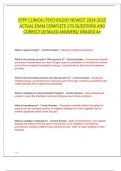EPPP CLINICAL PSYCHOLOGY NEWEST 2024-2025
ACTUAL EXAM COMPLETE 270 QUESTIONS AND
CORRECT DETAILED ANSWERS/ GRADED A+
What is signal anxiety? - Correct Answer - Impulse is seeking expression
What is the primary process? Who governs it? - Correct Answer - Unconscious mental
processes characterized by a lack of logic, ease of substitution of one idea for another
and by the immediate discharge of energy. It is governed by the id and the pleasure
principle.
What is the secondary process and who governs it? - Correct Answer - Conscious
mental process, governed by the conscious part of the ego, functions according to the
reality principle and is logical and sequential
What is resistance in psychoanalytic therapy? - Correct Answer - when patients are
unable to recall the traumatic memories that give rise to their symptoms
What is transference? - Correct Answer - Therapists neutrality allows the patient to
project onto the therapist positive or negative feelings he or she originally had for
another significant person from the past.
What is repetition compulsion? - Correct Answer - Apart of transference, one repeats
feelings and affects from the past in the present. As a repetition of unresolved
unconscious conflicts, patients may experience love, hate, or erotic feelings for their
therapist.
pg. 1
,What is positive transference? - Correct Answer - displaced love longings or the feelings
of affection, openness, and friendliness that allow for a working relationship between the
patient and the therapist/therapy.
A Gestalt therapist would most likely ____ a client's question:
a. analyzes
b. ignores
c. discourages
d. mimic - Correct Answer - C. Discourage - Gestalt therapists view questions as
fostering intellectualization and masking true feelings. Thus, Gestalt therapists typically
discourage their clients' questions.
For Carl Jung, projection of aspects of the collective unconscious onto the therapist
represents:
a. a form of transference
b. "symbolization" - Correct Answer - Jung believed that when transference occurs,
elements of the personal and collective (transpersonal) unconscious are projected onto
the therapist
An intervention is set up for all preschool children in a community whose mothers have
low IQs. The goal of the program is to counteract the potential negative effects of the
mothers' subaverage intellectual functioning on the children's development. This is an
example of:
a. primary prevention
b. secondary prevention
c. tertiary prevention - Correct Answer - C. The intervention is for all children of mothers
who have low IQs, not just for children who have been individually identified as having
early signs of developmental problems. Consequently, this program is best described as
primary prevention.
What did Fromm emphasize in personality development? - Correct Answer - The role of
societal factors
pg. 2
,What were the five character styles that a person may adopt in response to the
demands of society? Which one permits a person to realize his/her true human nature?
- Correct Answer - The receptive, the exploitative, the hoarding, the marketing, and the
productive.
The productive character style realizes human nature.
Who are the Ego Analysts? - Correct Answer - Anna Freud, David Rappaport, and Heinz
Hartmann
How did the Ego Analysts differ from Freud? - Correct Answer - Placed greater
emphasis on the ego's role personality development than Freud. View healthy behavior
under conscious control. More emphasis on current experiences and less on
transference.
What is the ego-defensive function? - Correct Answer - Resolution of conflict
What is the ego-autonomous function? - Correct Answer - Adaptive non conflict laden
functions such as learning, memory, speech, and perception
Who were the object relations theorists? - Correct Answer - Melanie Klein, Ronald
Fairbairn, Margaret Mahler, Otto Kernberg, Heinz Kohut, and Donald Winnicott
What is an object introjecting? - Correct Answer - Mental representation of a person,
either the self (self-representation) or another (object representation)
When and what is the "psychological birth" of a child? - Correct Answer - Occurs during
the third year of life, in a healthy environment, the infant’s ego comes to develop mental
representations of itself and others
How did Kohut describe narcissism? - Correct Answer - When a young child's natural
self-love (narcissism) is undermined by a parent's inevitable failure to satisfy all the
child's needs, the child develops a protective grandiose self
pg. 3
, Sullivan's concept of parataxic distortion is most similar to the Freudian notion of
a. resistance
b. catharsis
c. displacement
d. transference - Correct Answer - d. parataxic distortions occur when an individual
deals with others as if they were significant persons from his or her early life
From the perspective of ego-psychology, psychopathology results when the ego:
a. becomes too autonomous
b. loses its autonomy
c. is damaged due to overwhelming life circumstances
d. becomes swelled due to too much praise - Correct Answer - Anna Freud and Heinz
Hartmann, healthy behavior is under the ego's conscious control, and pathology may
result when the ego loses this control and its autonomy from the id
Why are humanistic approaches referred to as the "third force" in clinical psychology? -
Correct Answer - In contrast to psychodynamic and behaviorally orientated therapies,
which rely on a deterministic view of personality, existential/humanistic approaches
stress individuality and the inherent capacity for growth and change.
What is the basis for Carl Roger's client centered (or person centered) therapy? -
Correct Answer - It is based on the notion that we all have a self-actualizing tendency,
or capacity for natural growth, constructive change, and self-understanding, that guides
and motivates us.
What is the goal of client centered therapy? - Correct Answer - Decrease the
incongruence between the real self and the ideal self and realize the capacity for self-
actualization
What are the three facilitative conditions for client centered therapy? - Correct Answer -
1. Accurate empathic understanding 2. Unconditional positive regard 3. Congruence /
Genuineness
pg. 4




